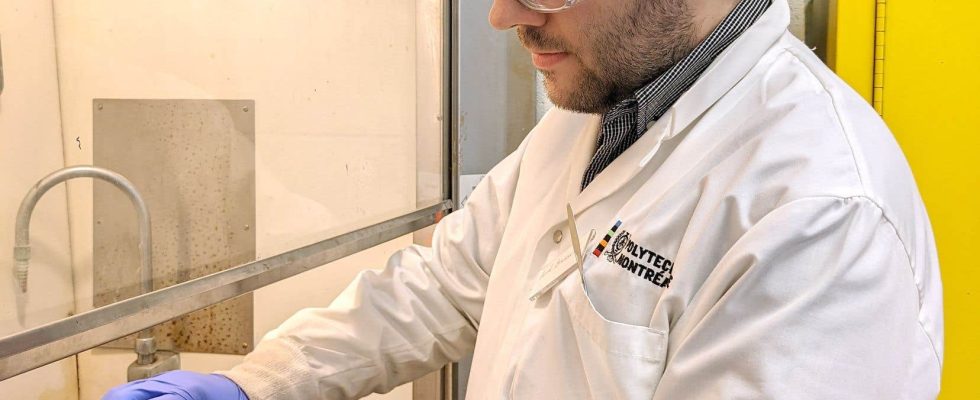This text is part of the special Research section
More than 5 billion people could have difficulty accessing water in 2050, according to the World Meteorological Organization (WMO). In collaboration with the company Awn Nanotech, a research team from Polytechnique Montréal has developed a clever technology: tiny sponges capable of absorbing water in the air and redistributing it when necessary. The invention will be tested in the homes of indigenous communities, some of which still have little or no access to drinking water.
In the world, 2 billion people are deprived of drinking water, and 3.6 billion do not have access to a safe sanitation system, warns a report on water published in 2023 by UNESCO and the UN. Water. Richard Boudreault, president and CEO of Awn Nanotech, a “clean” technology company, saw these difficulties right here in Canada.
“At one point, we had more than 200 boil water advisories and we found ourselves with high arsenic levels linked to pollution caused by mining activities,” says the former chairman of the board of Polar Knowledge Canada, an organization research on the Arctic. Several indigenous communities have not had access to water for decades. »
For the serial entrepreneur, himself from an indigenous community and president of the board of directors of the First Nations University of Canada, it was therefore necessary to act. “With climate change, the atmosphere is warmer and contains more water, but there is less on the ground and the water tables are no longer replenished,” continues the assistant professor at Polytechnique Montréal. When it falls, on the other hand, it is in large quantities. »
A “revolutionary” sponge
In this context, the idea of developing an economical and energy-efficient technology, capable of absorbing water from the atmosphere to make it drinkable, emerged. Mr. Boudreault first partnered with McGill University to start the project, now developed at Polytechnique Montréal by the team of Professor Jason R. Tavares, of which researchers affiliated with the English-speaking university are part.
“You have probably already noticed the small sachets of silica gel, present in shoes or in certain food packaging, to keep them dry,” explains Professor Tavares. These absorbents are very strong at capturing moisture from the air and holding it, but not at releasing it. We took inspiration from this to shrink the pores – small holes inside the material – in order to create a reversible process, like a sponge. »
The team uses an inexpensive carbon-based material with adjustable porosity. “We want to be able to cover all types of conditions, ranging from 95% relative humidity, like in a jungle, to 5%, in the desert,” specifies the researcher. According to his data, the water produced by these nanoporous sponges is of such purity that it must be remineralized in order to be consumed. To achieve this, it works with the Center for Research, Development and Validation of Water Treatment Technologies and Processes.
If the process has “competitors” working on similar projects, their technology would reportedly be much more expensive. “The one we have developed is extremely interesting, because the energy cost is very low. And that’s revolutionary,” enthuses Richard Boudreault.
It is also very useful for dehumidifying a space. “In the North, houses are relatively small and are inhabited by three generations, which creates a lot of humidity,” says Mr. Boudreault. To avoid this, the windows are open even in winter. » Heat loss and costs could therefore be minimized.
Legacy solutions
The scientific team, which has already developed several prototypes in the laboratory, is working to build other, larger ones in order to carry out tests in indigenous communities very soon. Richard Boudreault is currently interacting with different groups internationally, in Canada and in Quebec to gauge interest and needs for drinking water. Last December, the Liberal government tabled a bill aimed at improving water quality in communities and creating a new water commission, led by the First Nations themselves.
Awn Nanotech’s ultimate objective is to market a product in 2025, at a cost of around $1,000, which corresponds to the price of an industrial dehumidifier, “but much less energy-intensive,” specifies Richard Boudreault. “It is estimated that it could generate 20 liters to 100 liters of water per day depending on conditions, with a machine powered by solar energy. » The company is particularly targeting the market of cities in Mexico, California and other western states which are already facing major droughts.
Jason R. Tavares is proud of this project he has been working on since 2017, but especially of his students. “They are little pearls of innovation determined to work to resolve a problem that is both scientific and societal,” he reveals. Partnerships with industry can be very beneficial for students, who learn to understand economic issues. »
For his part, Richard Boudreault is keen to leave solutions behind him. “Our generation has taken a lot, so we have to give a lot,” he says.
This content was produced by the Special Publications team at Duty, relating to marketing. The writing of the Duty did not take part.
